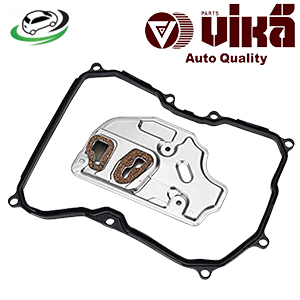-18%
Get Automatic Transmission Filter Volkswagen CC/Golf V/Golf VI/Jetta V/VI/New Beetle/Passat B6 09G325429A
The automatic transmission filter is a critical component in a vehicle’s automatic transmission system. Its primary function is to filter out contaminants from the transmission fluid, ensuring the smooth operation and longevity of the transmission. Understanding its role, benefits, common issues, and maintenance practices is essential for keeping your vehicle’s transmission in optimal condition.
What is an Automatic Transmission Filter?
An automatic transmission filter is a device that sits within the transmission system and is designed to capture contaminants such as metal shavings, dirt, and debris from the transmission fluid. This helps to prevent these particles from causing damage to the transmission’s internal components.
How Does an Automatic Transmission Filter Work?
The operation of an automatic transmission filter involves several key steps:
- Fluid Flow: Transmission fluid circulates through the transmission system, lubricating and cooling the components while transferring power from the engine to the wheels.
- Filtration: As the fluid flows through the transmission, it passes through the filter, which captures and holds contaminants.
- Clean Fluid: The filtered, clean transmission fluid continues to circulate through the system, ensuring that the transmission operates smoothly and efficiently.
Types of Transmission Filters
There are several types of transmission filters, each offering different advantages:
- Metal Mesh Filters: Made from fine metal mesh, these filters are durable and effective at capturing larger particles.
- Paper Filters: These filters are made from special paper material and are effective at capturing smaller particles, though they need to be replaced more frequently.
- Synthetic Filters: Made from synthetic materials, these filters offer high efficiency and durability, capturing a wide range of particle sizes.
Benefits of a Properly Functioning Transmission Filter
A well-maintained transmission filter provides numerous benefits for vehicle performance and longevity:
- Enhanced Performance: A clean transmission filter ensures that the transmission fluid remains free of contaminants, promoting smooth and efficient transmission operation.
- Increased Lifespan: By preventing contaminants from causing wear and damage, a clean filter helps to extend the lifespan of the transmission components.
- Preventative Maintenance: Regularly changing the transmission filter can prevent costly repairs and breakdowns, saving time and money in the long run.
- Improved Fuel Efficiency: A properly functioning transmission can improve fuel efficiency by ensuring that the engine and transmission work together smoothly.
- Optimal Shifting: Clean transmission fluid aids in smooth gear shifting, providing a better driving experience.
Common Issues with Transmission Filters
Over time, transmission filters can develop several issues that may affect their performance and the overall health of the transmission. Common problems include:
- Clogging: As the filter captures contaminants, it can become clogged, restricting the flow of transmission fluid and causing the transmission to overheat or malfunction.
- Wear and Tear: Like any component, transmission filters can wear out over time and lose their effectiveness, allowing contaminants to pass through.
- Leaks: Damaged or improperly installed filters can cause transmission fluid leaks, leading to low fluid levels and potential damage to the transmission.
- Contaminant Buildup: Excessive contaminant buildup can overwhelm the filter, leading to reduced filtration efficiency and potential damage to the transmission.
Signs of a Failing Transmission Filter
Identifying the signs of a failing transmission filter can help address issues before they lead to more severe problems. Common symptoms include:
- Shifting Problems: Difficulty shifting gears, slipping gears, or rough shifting can indicate a clogged or failing transmission filter.
- Overheating: If the transmission overheats, it may be due to restricted fluid flow caused by a clogged filter.
- Unusual Noises: Whining, buzzing, or other unusual noises from the transmission can be a sign of a clogged filter restricting fluid flow.
- Fluid Leaks: Transmission fluid leaks can indicate a damaged or improperly installed filter.
- Dirty Fluid: Dark, dirty, or contaminated transmission fluid can indicate that the filter is not effectively capturing contaminants.
Maintenance and Replacement
Regular maintenance and timely replacement of the transmission filter are essential for ensuring reliable transmission performance and longevity. Here are some maintenance tips:
- Regular Inspections: Periodically inspect the transmission fluid and filter for signs of contamination or damage. Regular maintenance can help identify issues early and prevent more severe problems.
- Follow Manufacturer’s Guidelines: Adhere to the manufacturer’s recommended service intervals for transmission filter and fluid changes.
- Use High-Quality Parts: When replacing the transmission filter, use high-quality parts that meet or exceed the manufacturer’s specifications to ensure durability and performance.
- Check for Leaks: Regularly check for transmission fluid leaks and address them promptly to prevent low fluid levels and potential damage.
Replacement Procedure
Replacing a transmission filter typically involves the following steps:
- Preparation: Ensure the vehicle is on a level surface and secure it with jack stands if necessary. Gather the necessary tools, a replacement filter, and new transmission fluid.
- Drain the Fluid: Remove the transmission pan to drain the old transmission fluid into a suitable container. Be careful to avoid spills.
- Remove the Old Filter: Locate the transmission filter and carefully remove it, noting its position and orientation.
- Install the New Filter: Install the new transmission filter in the same position and orientation as the old one. Ensure it is securely in place.
- Replace the Pan Gasket: If necessary, replace the transmission pan gasket to ensure a proper seal and prevent leaks.
- Reinstall the Transmission Pan: Reinstall the transmission pan and secure it with the appropriate bolts or fasteners.
- Refill with Transmission Fluid: Refill the transmission with the recommended type and amount of transmission fluid.
- Check for Leaks and Proper Operation: Start the engine and check for any leaks. Test drive the vehicle to ensure the transmission is operating smoothly and shifting correctly.
Follow us on Facebook for more parts.





